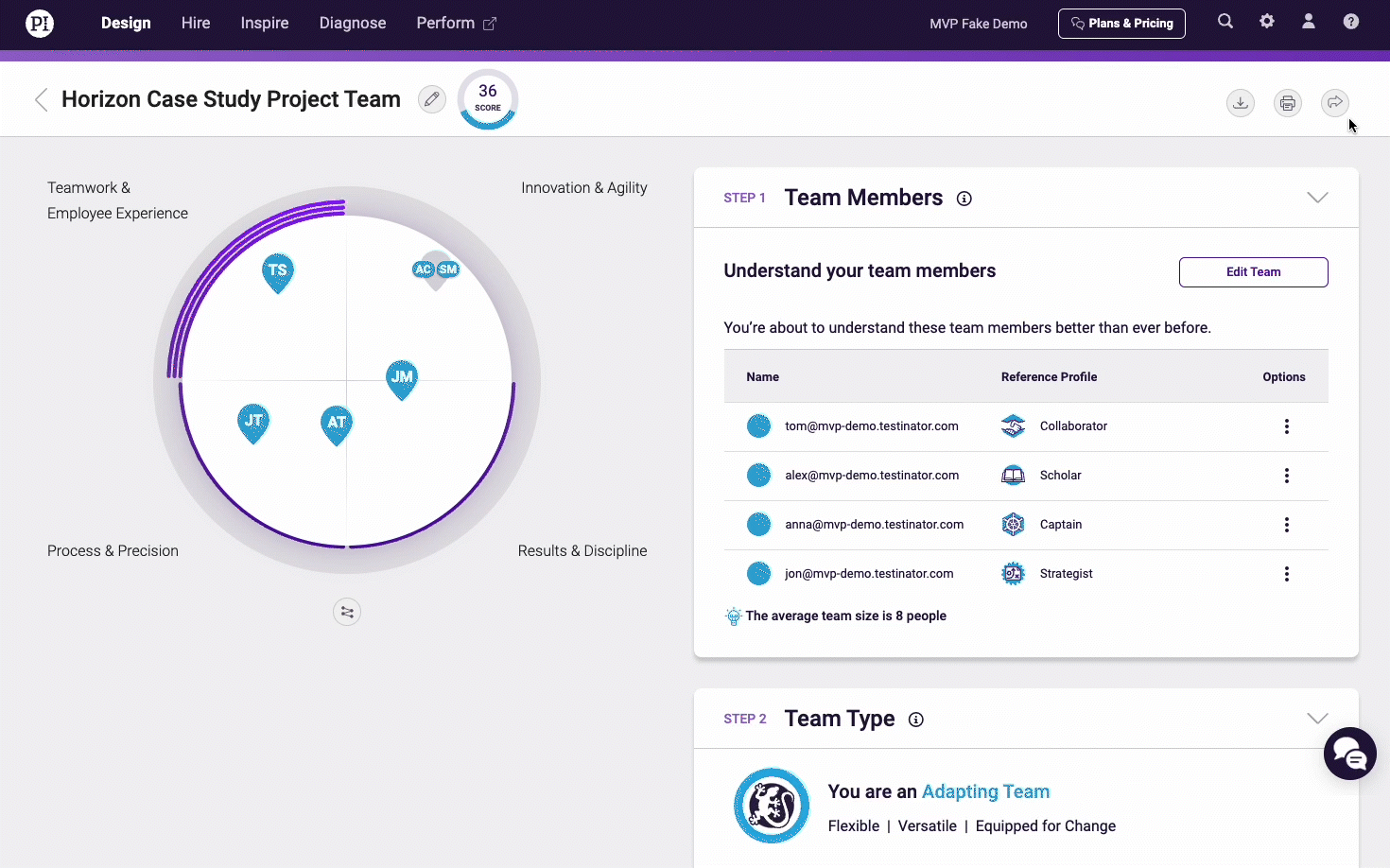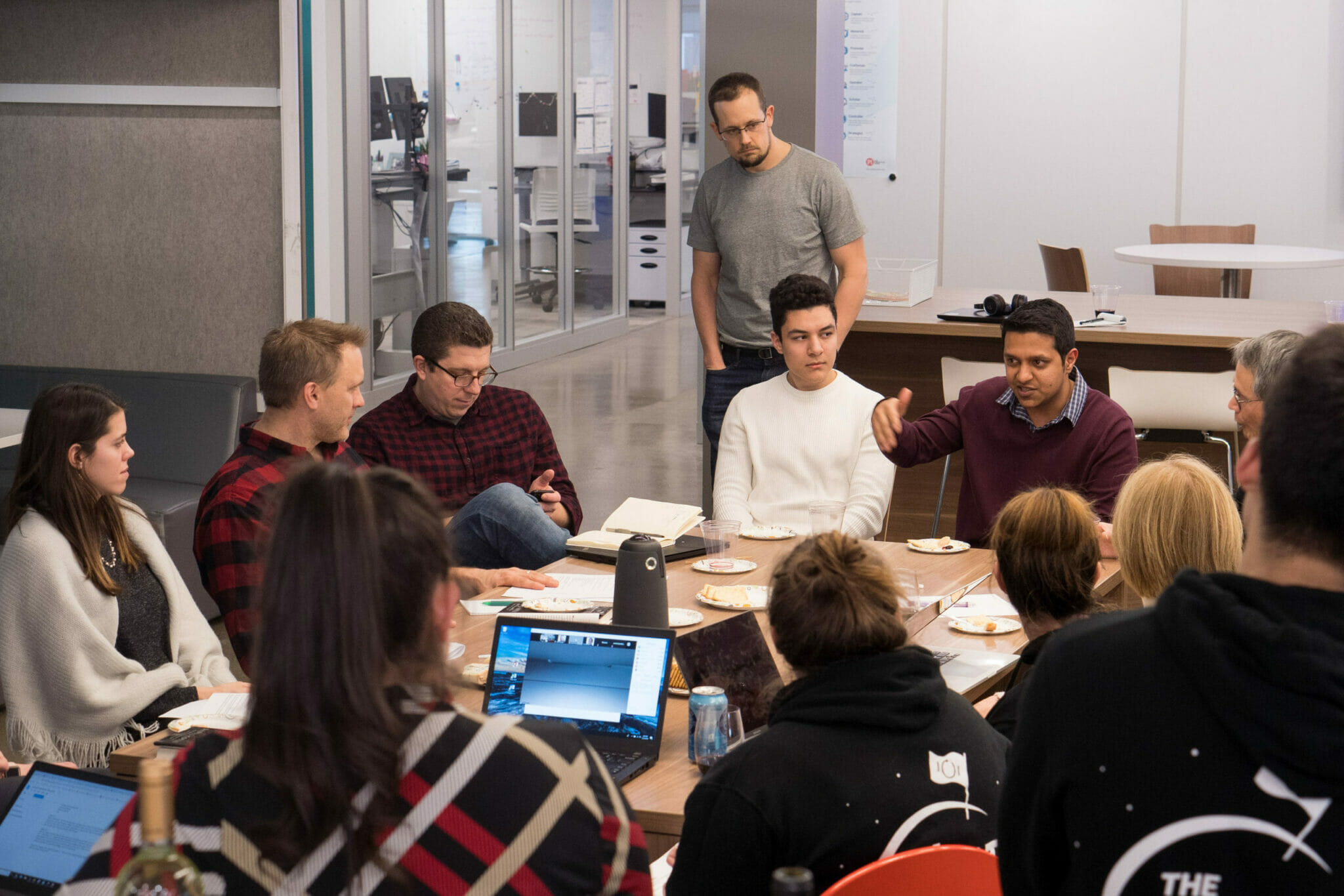As the future of leadership is multimodal, a company’s success will hinge on its leaders’ ability to assemble and manage high-performing hybrid teams. There’s no shortage of tips for managing hybrid teams. You’ll find good thought leadership on the topic, too, like Harvard Business Review’s thoughtful article on creating the office of tomorrow.
PI clients have an additional tool for managing hybrid teams: PI Design™.
Maybe you’re preparing to return to the office and navigate a hybrid work model. Or perhaps you’re an expert at leading distributed teams by now. Either way, the Team Discovery™ tool within PI Design will help you enhance hybrid team dynamics and mitigate hybrid team struggles—so you can sail confidently into the future of work, and your team can thrive in this new environment.
The impact of behavioral drives in a hybrid workplace
Successfully leading a hybrid team requires leaders to:
- Understand how individual team members are behaviorally-wired
- Understand the team’s collective behavioral makeup or “Team Type”
- Understand the impact of behavioral drives in a remote workplace
- Understand the impact of behavioral drives in a hybrid workplace
Let’s look at an example. Captains are dominant and extraverted. With an innate need to make an impact and influence the work to be done, Captains often use body language to command a room and get their opinions heard. When interacting virtually, it’s harder for them to do this. And it takes a toll: Captains are 23% less likely to feel heard at virtual meetings compared to in-person meetings.
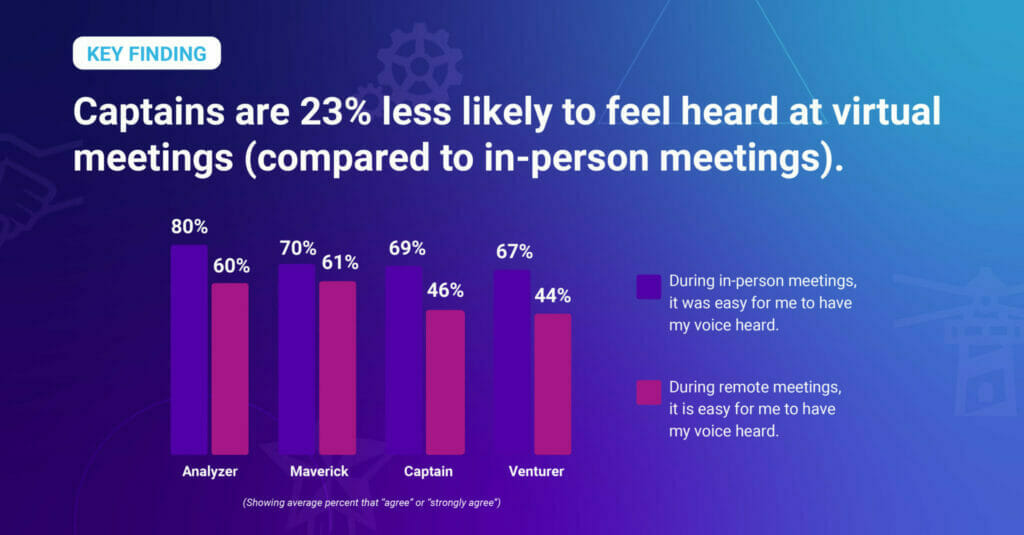
When some employees are in-office and some employees are working from home, it can be even more difficult for Captains—and other high-Dominance Reference Profiles—to get their needs met. Read on to learn actionable strategies for mitigating problems caused by hybrid work environments.
Use PI Design to improve hybrid team dynamics.
Note: If you’re new to PI Design, start here. If you’re looking to maximize your use of Teams, skip ahead to the Become a PI Design power user section.
Communication, decision-making, and conflict resolution can easily go awry when co-workers are in different locations—especially when behavioral needs aren’t being met due to the work environment.
Through self-awareness and empathy, your team members’ ability to embrace different work styles can set the stage for top-notch team dynamics, regardless of where each individual is located.
Using the Team Discovery tool, complete these four steps to discover your Team Type and improve hybrid team dynamics:
1. Build awareness.
First, create a new team and add your team members to it. From within the software, you can invite your team members to take the PI Behavioral Assessment.™ They’ll receive an email notification prompting them to login. After they complete it, you’ll see them plotted into one of four quadrants.
Now you have valuable people data. It helps you become aware of how each team member prefers to communicate, make decisions, and resolve conflict.
2. Gain insight.
Click on any person’s initials to view their strengths, preferred work style, and potential blind spots. Notice which quadrant each person falls into–and if you have any “flexors.” These individuals are plotted close to the center, which means they’re highly adaptable depending on team needs.
Ask yourself: How are my team members’ natural work styles similar? How are they different? What degree of empathy needs to be in place to meet in the middle and satisfy each person’s needs?
Next, click to find out your Team Type. As mentioned above, this is your team’s collective behavioral style. You’ll see team strengths, potential blind spots, and team building activities.
3. Take action.
Have a conversation with your team. Walk them through each individual’s behavioral overview, as well as the team’s collective strengths and blind spots. Invite their feedback.
Click to download the Team Building Activities Worksheet. Together, decide how you will communicate, make decisions, resolve conflict, and support each others’ natural work styles. Discuss how your hybrid team will collaborate and maintain team culture, even when distributed.
4. Follow through.
Hold yourself and your team accountable for supporting this way of working so you as a hybrid team can be just as—if not more—effective as a team working in the same physical location.
You’ll likely have team members in different quadrants. Some may focus on innovation, others on process. Some may be people-focused, others add discipline. Each of these work styles plays out differently depending on whether you’re managing an in-office employee or a remote worker.
You’ll likely have team members in different quadrants. Some focus on innovation, others on process. Some employees are people-focused and others focus on results. Each of these work styles plays out differently depending on whether you are managing an employee in the office or a remote employee. The following pages provide insights on how your employees may show up at work differently given their work location, and offer tips to effectively manage your hybrid team.
Join 10,000 companies solving the most complex people problems with PI.
Hire the right people, inspire their best work, design dream teams, and sustain engagement for the long haul.
Become a PI Design power user
Note: The following section is for PI Design users who have discovered their Team Type and would like to derive more value from the software as it pertains to managing remote and hybrid employees.
The following four sections explain how your employees may show up at work differently given their personality and their work location. Each section offers tips to effectively manage your hybrid team.
1. Innovation & Agility
Employees in the Innovation & Agility quadrant tend to:
- Communicate by talking things through and brainstorming out loud
- Make decisions independently, without waiting for consensus
- Resolve conflict by focusing on the people involved
You may notice the following behaviors among your team members in different locations:
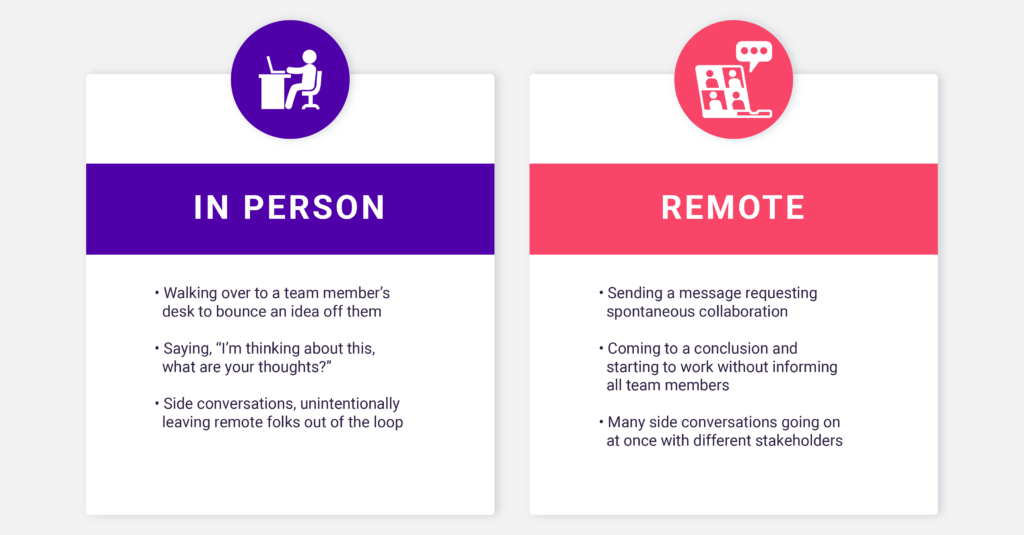
Potential struggles for hybrid teams in this quadrant:
- Spontaneous conversations can lead to important parties accidentally being left out of important decisions.
- Asynchronous decision-making can mean it takes longer to settle on a decision. Also, it can leave some team members out-of-the-loop if they’re unavailable while the conversation is going on.
- Side conversations with different stakeholders can lead to mixed messages—or wasting time responding to problems that are no longer relevant.
Manager tips to enhance hybrid team dynamics:
- During your weekly team meetings, save time for “show and tell” where each team member shares what they’re working on, and invites feedback from the team.
- Encourage face-to-face collaboration, whether in person or through video conferencing, to ensure communication and tone are not lost in typing.
- Make an extra effort to summarize all side conversations about a project with the greater group, so no communication or discussion points are lost.
2. Teamwork & Employee Experience
Employees in the Teamwork & Employee Experience quadrant tend to:
- Communicate by talking things through and brainstorming things out loud
- Make decisions collaboratively, seeking input from each involved team member
- Resolve conflict by focusing on the people involved
You may notice the following behaviors among your team members in different locations:
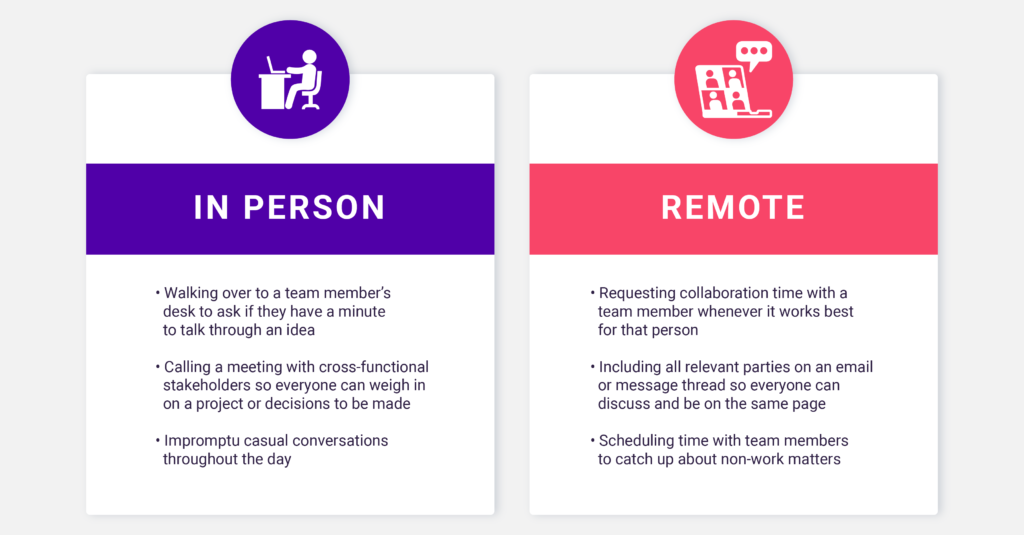
Potential struggles for hybrid teams in this quadrant:
- Team members may find it harder to ask for help if they have to send an email or book a Zoom meeting rather than reaching out more informally to a neighboring colleague.
- Gathering input from everyone who should be involved in a decision can be a time-intensive process, especially when not everyone is in the same location.
- Remote employees may struggle to find a sense of community on the team if they aren’t able to attend team lunches, team outings, or participate in casual conversations.
Manager tips to enhance hybrid team dynamics:
- When onboarding a new hire or introducing a new process, block off time on your calendar for impromptu questions—or dedicated time to walk through the task with the team to make sure everyone feels comfortable with the work.
- Start your weekly team meetings with “Events or Brags” from home life. Consciously set aside this time so people can share pieces of who they are outside the workplace.
- Set communication standards regarding who needs to be involved in discussions and when. RACI charts can also help move group projects along more quickly.
3. Process & Precision
Employees in the Process & Precision quadrant tend to:
- Communicate concisely, after thorough independent reflection
- Make decisions collaboratively, seeking input from each involved team member
- Resolve conflict by focusing on the task at hand
You may notice the following behaviors among your team members in different locations:

Potential struggles for hybrid teams in this quadrant:
- Dynamics may suffer as team members only know each other as co-workers, not as people outside of work.
- Certain team members’ voices may not be heard if they don’t feel comfortable speaking up when some are in the room and others are on the Zoom.
- Decision speed may slow down as people seek to collaborate asynchronously while not leaving anyone out.
Manager tips to enhance hybrid team dynamics:
- Set aside some time as a team to play a game, have a happy hour, or chat. Encourage folks to get to know each other regardless of their location.
- Adopt a meeting cadence where each person is asked to share their thoughts. If they don’t speak up on their own, let them know you’ll call on them to speak.
- Give people the information they need to make decisions ahead of the actual conversation. Set expectations that discussion will happen and a decision will be made by a specific deadline.
4. Results & Discipline
Employees in the Results & Discipline quadrant tend to:
- Communicate concisely, after thorough independent reflection
- Make decisions independently, without waiting for consensus
- Resolve conflict by focusing on the task involved
You may notice the following behaviors among your team members in different locations:

Potential struggles for hybrid teams in this quadrant:
- Dynamics may suffer if team members are so task-focused they appear brusque and unfriendly.
- The urge to move as fast as possible could lead to people being left out of the decision-making process if the entire team is not able to be gathered together at the same time.
- Team members may feel like information is told to them instead of shared with them if they never have an opportunity to talk through decisions or weigh in on organization-wide happenings.
Manager tips to enhance hybrid team dynamics:
- Remind your team members to start all email and Slack conversations with a simple greeting; don’t just lead with their question or comment about work.
- When all team members can’t participate in a conversation, try to think about questions they might ask. Take notes to share with them about the discussion they missed—or record the call.
- When information is shared, take the time to pull the entire team together for discussion, regardless of where they are. Invite team members to share what their cross-functional teammates may be hearing, from in the office or other channels used by remote workers.
Build a foundation of trust for your hybrid team
Trust is the essential building block of teams. Understanding each other on a deeper level can help build trust and psychological safety on your team. Be sure to collect frequent feedback to keep a pulse on team sentiment. Things won’t always go as planned, but your team will see that you’re actively trying to meet individual needs, for the whole hybrid team. And that’s the type of leadership people need.



